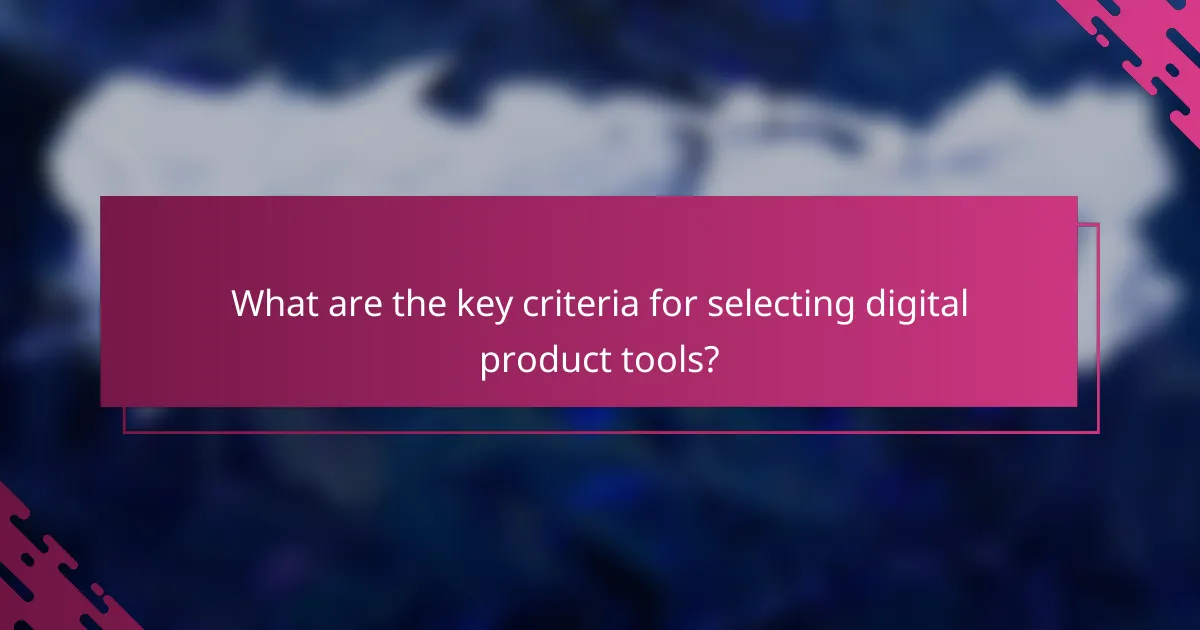In the rapidly evolving landscape of digital product development, staying ahead of trends is crucial for success. Emphasizing user experience, leveraging emerging technologies like artificial intelligence and augmented reality, and adopting agile practices can significantly enhance a business’s adaptability. By focusing on scalability and integration when selecting tools, organizations can ensure they remain competitive and responsive to market demands.

What are the latest digital product development trends?
The latest trends in digital product development focus on enhancing user experience, streamlining processes, and leveraging emerging technologies. Key areas include artificial intelligence, remote collaboration, subscription models, low-code platforms, and augmented reality applications.
Artificial Intelligence integration
Artificial intelligence (AI) integration is transforming digital products by enabling smarter functionalities and personalized experiences. Businesses are increasingly using AI for data analysis, customer service automation, and predictive analytics, which can enhance decision-making and user engagement.
When implementing AI, consider the specific needs of your users and the type of data you have. For example, chatbots can improve customer support, while recommendation engines can drive sales. However, ensure compliance with data privacy regulations, such as GDPR in Europe.
Remote collaboration tools
Remote collaboration tools have become essential for teams working in distributed environments. These tools facilitate communication, project management, and file sharing, allowing teams to work efficiently regardless of location.
Popular tools include Slack for messaging, Trello for project tracking, and Zoom for video conferencing. When selecting tools, prioritize user-friendly interfaces and integration capabilities with existing systems to enhance productivity and minimize disruptions.
Subscription-based models
Subscription-based models are gaining traction as they provide a steady revenue stream and foster customer loyalty. This approach allows users to access products or services for a recurring fee, which can be more appealing than one-time purchases.
Consider offering tiered subscription plans to cater to different user needs and budgets. For instance, software companies often provide basic, professional, and enterprise plans. Be mindful of customer retention strategies, as maintaining subscribers is crucial for long-term success.
Low-code/no-code platforms
Low-code and no-code platforms empower users to create applications with minimal programming knowledge. These platforms enable faster development cycles and allow non-technical users to contribute to product development, which can accelerate innovation.
Examples include platforms like Bubble and OutSystems, which provide drag-and-drop interfaces for building apps. While these tools can significantly reduce development time, ensure that they meet your scalability and security requirements before full implementation.
Augmented Reality applications
Augmented reality (AR) applications are increasingly being used to enhance user experiences by overlaying digital information onto the real world. This technology is particularly popular in retail, education, and gaming, offering immersive interactions that engage users more effectively.
For instance, AR can allow customers to visualize products in their environment before purchasing. When developing AR applications, focus on user experience and ensure that the technology is accessible across various devices to maximize reach and engagement.

How can businesses adapt to these trends?
Businesses can adapt to digital product development trends by embracing continuous learning, agile practices, and actively incorporating user feedback. These strategies help organizations remain competitive and responsive to market changes.
Invest in training and upskilling
Investing in training and upskilling is crucial for keeping teams updated with the latest technologies and methodologies. Companies should allocate resources for workshops, online courses, and certifications that align with current industry trends.
Consider establishing a regular training schedule, allowing employees to learn new skills while balancing their workload. This can enhance team capabilities and foster a culture of innovation.
Implement agile development methodologies
Agile development methodologies enable businesses to respond quickly to changes and improve product quality through iterative processes. By adopting frameworks like Scrum or Kanban, teams can enhance collaboration and increase productivity.
Start by breaking projects into smaller, manageable tasks and conducting regular reviews. This approach helps identify issues early and allows for adjustments based on stakeholder feedback, ultimately leading to a more refined product.
Utilize user feedback for product iterations
Utilizing user feedback is essential for refining digital products and ensuring they meet customer needs. Regularly gathering insights through surveys, interviews, or usability testing can inform development decisions and prioritize features that enhance user experience.
Establish a feedback loop where users can easily share their thoughts, and integrate this feedback into your development cycles. This practice not only improves product quality but also builds customer loyalty by showing that their opinions are valued.

What are the key criteria for selecting digital product tools?
When selecting digital product tools, key criteria include scalability, integration capabilities, and user experience. These factors ensure that the tools can grow with your business, work seamlessly with existing systems, and provide a positive experience for users.
Scalability of the platform
Scalability refers to a platform’s ability to handle increased loads and user demands without compromising performance. When evaluating tools, consider how easily they can expand to accommodate growth, whether in user numbers, data volume, or feature sets.
Look for platforms that offer tiered pricing or modular features, allowing you to pay for only what you need initially and scale up as your requirements grow. This flexibility can save costs in the long run.
Integration capabilities with existing systems
Integration capabilities determine how well a digital product tool can connect with your current systems and workflows. Effective integration minimizes disruptions and enhances efficiency by allowing data to flow seamlessly between applications.
Check for compatibility with popular software and APIs that your organization already uses. Tools that support standard integration protocols, such as REST or SOAP, are often easier to implement and maintain.
User experience and interface design
User experience (UX) and interface design are crucial for ensuring that users can navigate and utilize the tool effectively. A well-designed interface can significantly reduce training time and improve overall satisfaction.
Prioritize tools that offer intuitive layouts, responsive designs, and customizable features. Conduct user testing or gather feedback from potential users to assess usability before making a decision.

What are the pricing models for digital products?
Digital products can be priced using various models, each with distinct advantages and considerations. Understanding these pricing structures is essential for maximizing revenue and meeting customer expectations.
Freemium models
Freemium models offer basic features for free while charging for premium functionalities. This approach allows users to experience the product without any upfront cost, potentially leading to higher conversion rates for paid upgrades.
When implementing a freemium model, it’s crucial to balance free and paid features effectively. Offering enough value in the free version can attract users, but the premium features must be compelling enough to encourage upgrades. Examples include software like Spotify, which provides free music streaming with ads and a paid ad-free experience.
One-time purchase options
One-time purchase options require customers to pay a single fee to access the product indefinitely. This model is straightforward and appealing for users who prefer not to commit to ongoing payments.
However, businesses should consider the potential for limited revenue growth with this model, as it relies on new customer acquisition rather than recurring income. Examples include mobile apps or software sold on platforms like the Apple App Store, where users pay once for full access.
Recurring subscription fees
Recurring subscription fees involve charging customers at regular intervals, such as monthly or annually, for continued access to a product or service. This model provides predictable revenue streams and encourages ongoing customer engagement.
When adopting a subscription model, it’s essential to offer consistent value to retain subscribers. Consider tiered pricing to cater to different user needs and budgets. Popular examples include Adobe Creative Cloud and Netflix, which provide a range of content and services for a monthly fee.

What proof points support successful digital product development?
Successful digital product development is supported by tangible evidence such as case studies from industry leaders and user testimonials. These proof points provide insights into effective strategies and highlight the impact of user feedback on product evolution.
Case studies from leading companies
Case studies from top companies like Apple and Spotify illustrate how strategic development practices lead to successful digital products. For instance, Apple’s iterative design process emphasizes user experience, resulting in high customer satisfaction and loyalty.
Spotify employs data-driven decision-making to refine its features, using analytics to understand user behavior and preferences. This approach not only enhances user engagement but also drives continuous improvement in their offerings.
User testimonials and reviews
User testimonials and reviews serve as critical feedback mechanisms that inform product development. Positive reviews can validate a product’s effectiveness, while constructive criticism highlights areas for improvement. Companies often analyze this feedback to prioritize feature updates and enhancements.
For example, a software tool that receives consistent praise for its user interface may prompt developers to maintain that design philosophy in future updates. Conversely, negative feedback regarding functionality can lead to immediate revisions, ensuring the product meets user expectations.



